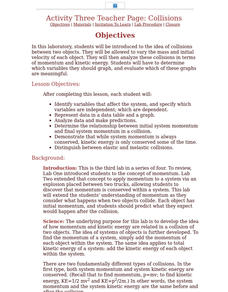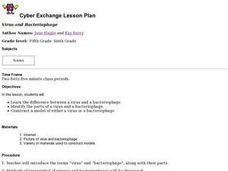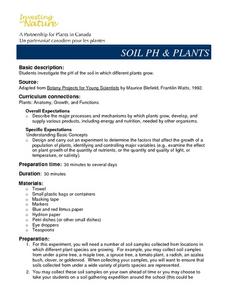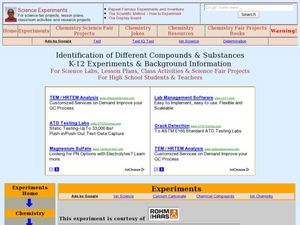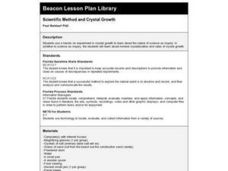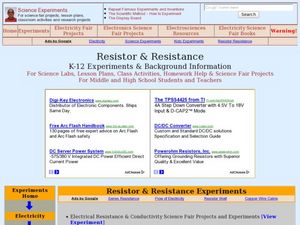Curated OER
Separation of Unknowns in a Liquid
Students identify chromatography as method of separating the components of a liquid. Students discover that dyes are composed of more than one component in achieving a particular color in these lessons on paper chromatography.
Curated OER
A Self Directed Inquiry into the Identification of Unknowns
Students gain experience in designing an experiment and use logic in selecting specific tests for unknowns. Students recognize the use of spreadsheets in helping one to make clear comparisons.
Curated OER
The Catapult
Students identify the advantages and disadvantages of a catapult as a weapon. In this physics lesson, students construct their own catapult. They investigate how changing one variable affects results.
Curated OER
What is That White Stuff?
Fifth graders identify, through experimentation, what properties of substance are, determine what variables tested will be, identify constants and variables of experiment, conduct experiment to conclusion with measurable, recorded...
Curated OER
Activity One Teacher Page: Vehicles In Motion
Students identify variables that affect the system, and specify which variables are independent and which are dependent.
Curated OER
Activity Three Teacher Page: Collisions
Young scholars after completing this lesson, identify variables that affect the system, and specify which variables are independent; which are dependent. They represent data in a data table and a graph and analyze data and make predictions.
Curated OER
Rate of Solution Lab
For this rate of solution worksheet, learners determine how quickly a solute dissolves in a solvent by testing one independent variable such as temperature, particle size or the amount of stirring. Students design their experiments and...
Curated OER
The Identification of Bacteria
Students are given a two week period to put to use the knowledge they have gained while studying bacteria. As a culminating activity, students each receive three unknown bacteria to identify.
Curated OER
Virus and Bacteriophage
Students examine the differences between a virus and a bacteriophage. They explore various websites, identify the parts of a virus and a bacteriophage, and construct a model of a virus or bacteriophage.
Curated OER
Fizzy Pop
Fifth graders compare and identify variables that affect the rate of a chemical change using Alka-Seltzer, water, ice, and hot water. They time how long each variable takes to pop the canister into the air, and record the results on a...
Curated OER
Incline Planes
Young scholars determine the forces necessary to move a truck on an inclined plane with weight and slope as variables. They identify the cheapest way to transport trash to local garbage disposal sites.
Curated OER
Soil pH & Plants
Students investigate the pH of the soil in which different plants grow. They design and carry out an experiment to determine the factors that affect the growth of a population of plants, identifying and controlling major variables...
Curated OER
Using Vegetation, Precipitation, and Surface Temperature to Study Climate Zones
Learners begin their examination of the climate zones found around the world. Using a software program, they identify the relationship between the vegetation, climate and temperatures of the different zones. They also plot coordinates...
Curated OER
Voltage, Current, Resistance
In this voltage, current and resistance learning exercise, students answer 21 questions about voltage, current and resistance. They find the current in batteries, they find the voltage in a resistor and they identify the voltage in...
Curated OER
Identification of Different Compounds and Substances
Students conduct a series of tests to identify unknown compounds. In this chemistry lesson, students compare the physical and chemical properties of substances. They collect data and formulate a conclusion.
Curated OER
Food Energy
Students compare the energy value of traditional foods eaten by indigenous people with those of modern commercial foods. They use a calorimeter to measure and calculate the amount of stored energy in various food types, and identify the...
Curated OER
The Spectrum of a Star
Tenth graders identify stars based on their line spectra. In this astronomy lesson, 10th graders analyze spectrograph and determine the elements present in the star. They explain the relationship between temperature and star classes.
Curated OER
Energy
In this energy worksheet, students answer 17 questions about kinetic and potential energy. They calculate potential energy, they write formulas for kinetic energy, they solve equations for kinetic energy and they identify types of energy...
Curated OER
Graphing Linear Motion
In this graphing linear motion instructional activity, students answer 20 questions about velocity of objects, the distance they travel and the time. They interpret a graph of position vs. time and identify the velocity at certain point...
Curated OER
Density as a Unique Physical Property
Students find the density of objects by finding their mass and their volume. In this density lesson plan, students determine the mass of objects, the find the volume by using formulas or by water displacement and they calculate the...
Curated OER
Collecting and Classifying Pollen
Students collect and analyze pollen from different species of plants. In small groups, they classify pollen according to shape, size and physical characteristics. They draw the basic anatomy of flowering plants and create a dichotomous...
Curated OER
Scientific Method and Crystal Growth
Students conduct a hands-on experiment growing crystals to demonstrate the nature of science as inquiry. They discuss and test variables that affect crystal growth. They research mineral crystallization and mineral formation on the...
Curated OER
Resistor and Resistance
Young scholars explore electrical resistance through various experiments. In this physics lesson plan, students calculate resistance using a mathematical formula. They explain how colors identify the resistance value of a resistor.
Curated OER
Cooking Up the Scientific Method
First graders identify the different steps of the scientific method. In this life science lesson, 1st graders apply this method when conducting a series of hands-on activities. They collect data and write observations in their journals.







